Difference between revisions of "Messenger RNA Vaccine"
| Line 74: | Line 74: | ||
1:Jan 11, 2019-nCov sequence released, Jan 14 VRC and Moderna Collaborate on COVID-19 vaccine design, Mar 16 1 st Phase 1 trial of USG- supported COVID-19 vaccine begins enrolling(Moderna mRNA)<br> | 1:Jan 11, 2019-nCov sequence released, Jan 14 VRC and Moderna Collaborate on COVID-19 vaccine design, Mar 16 1 st Phase 1 trial of USG- supported COVID-19 vaccine begins enrolling(Moderna mRNA)<br> | ||
2:Nov. 16 Moderna announces results of interim analysis from phase 3study<br> | 2:Nov. 16 Moderna announces results of interim analysis from phase 3study<br> | ||
===SARS=== | ===SARS=== | ||
[[File:2MRV_04_06.png|frameless|1000px|SARS]]<br> | [[File:2MRV_04_06.png|frameless|1000px|SARS]]<br> | ||
1:SARS was recognized as an emerging infectious disease in March 2003. The study from December 13, 2004 through May 2, 2005 (DNA vaccine) <br> | |||
=Alignment with Company Strategic Drivers= | =Alignment with Company Strategic Drivers= | ||
Revision as of 03:02, 12 October 2023
Roadmap Overview
This roadmap gives a structured overview of the mRNA vaccine technology, breaking down each phase into specific processes and tasks. Each step is crucial to ensuring the safety, efficacy, and availability of the vaccine to the masses.
Vaccine Development Technologies (1VDT)
- 2LAV: Live-attenuated vaccines
- 2IAV: Inactivated vaccines
- 2SUV: Subunit vaccines
- 2TXV: Toxoid vaccines
- 2VVV: Viral vector vaccines
- 2MRV: Messenger RNA (mRNA) vaccine
Discovery (3DCY)
The initial phase focuses on identifying and understanding the genetic composition of the target virus and creating a blueprint for the mRNA vaccine.
- 4SVI: Structural inference from viral nucleotide information
- 4MRD: mRNA design
- 4MRS: mRNA Synthesis
- 4MRM: mRNA modification
- 4LMS: Lipid Membrane Synthesis
Development (3DVT)
This stage involves testing the designed vaccine in human trials and ensuring its safety and efficacy.
- 4RMH: Risk Management of the Human Body
- 4CTM: Clinical Trial Management
Manufacturing Process (3MFP)
Once approved, the vaccine goes into mass production, ensuring that each component is assembled accurately and in the required quantities.
- 4MMS: mRNA mass synthesis (scale-up)
- 4MLS: Massive lipid synthesis
- 4MSB: Mass synthesis of buffers and other excipients
- 4MVA: Mass vaccine assembly
Actual Vaccination Situation
This final stage involves the distribution and administration of the vaccine to individuals, ensuring that they gain immunity. (Note: No specific sub-processes are provided for this step)
Design Structure Matrix (DSM) Allocation
The DSM illustrates the interplay between the tools and methods that constitute the Messenger RNA Vaccine. A 'X' sign denotes that the techniques are interconnected.

Roadmap Model using OPM
Discovery
The discovery process spans from obtaining the genetic information of the target virus to the phase just before the commencement of human clinical trials.
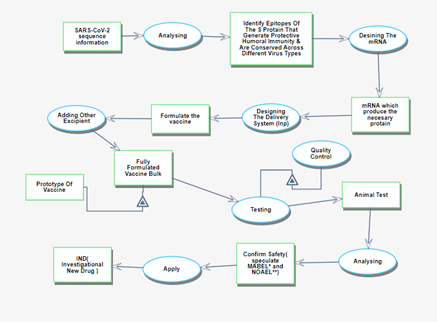
Development
The development process begins with the first human clinical trial and continues until the drug receives approval.
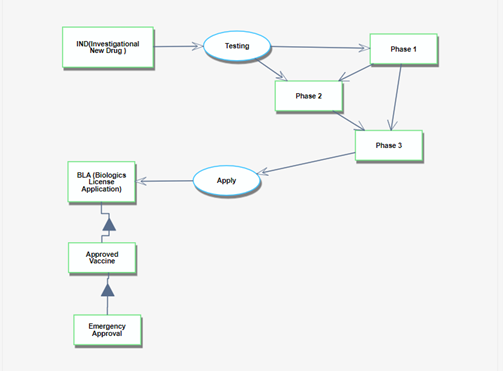
Manufacturing process
The manufacturing process begins after the drug has been approved. It starts with the assembly of each ingredient component and continues through to the shipment of the finished vaccine products.
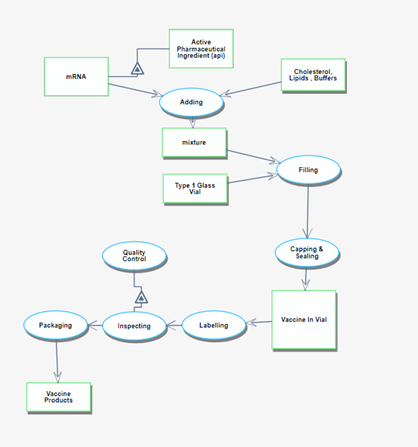
Actual Vaccination Situation
The Actual Vaccination Situation refers to the process that starts with receiving the vaccine products at the vaccination site and culminates in individuals gaining immunity after being administered the vaccines.
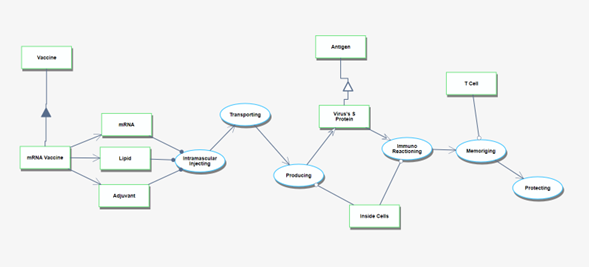
Figures of Merit
Below is a history of vaccination innovations. While we don't have vaccines for certain diseases, the chart highlights the year in which the causative agent was linked to the disease and the year the vaccine received licensing in the US for various diseases.
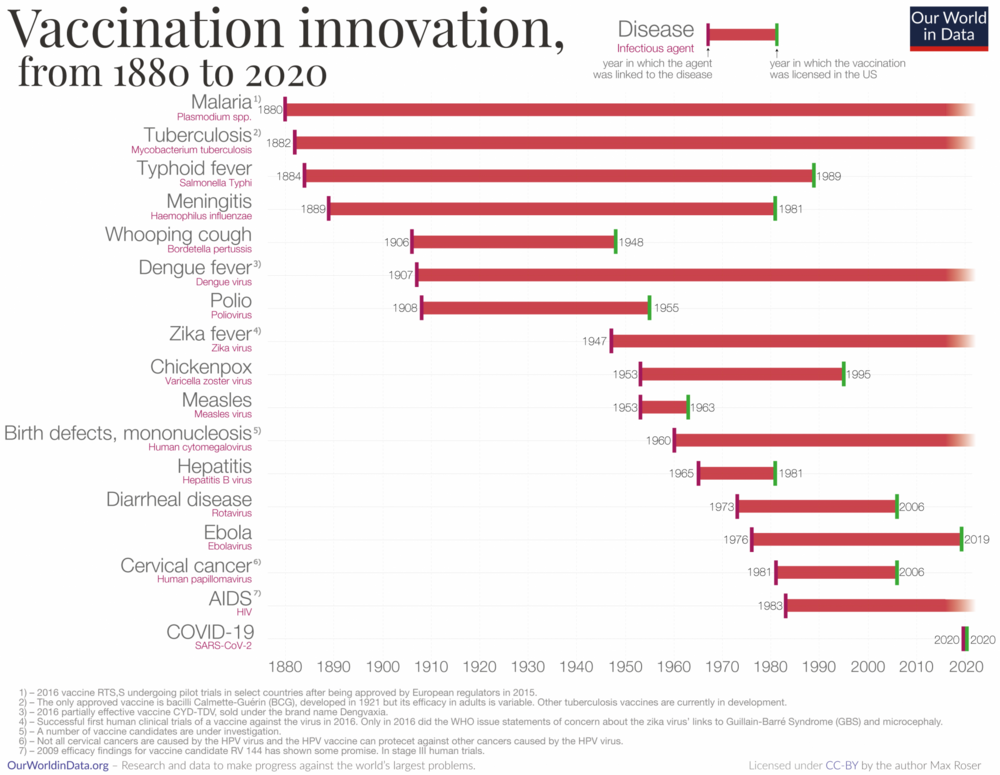
Based on the graph above, we have constructed the table below. This table indicates the duration taken for vaccine development. For the years, we've calculated the midpoint between the year the causative agent was linked to the disease and the year the vaccine received licensing in the US.

From the table above, we created the graph below.
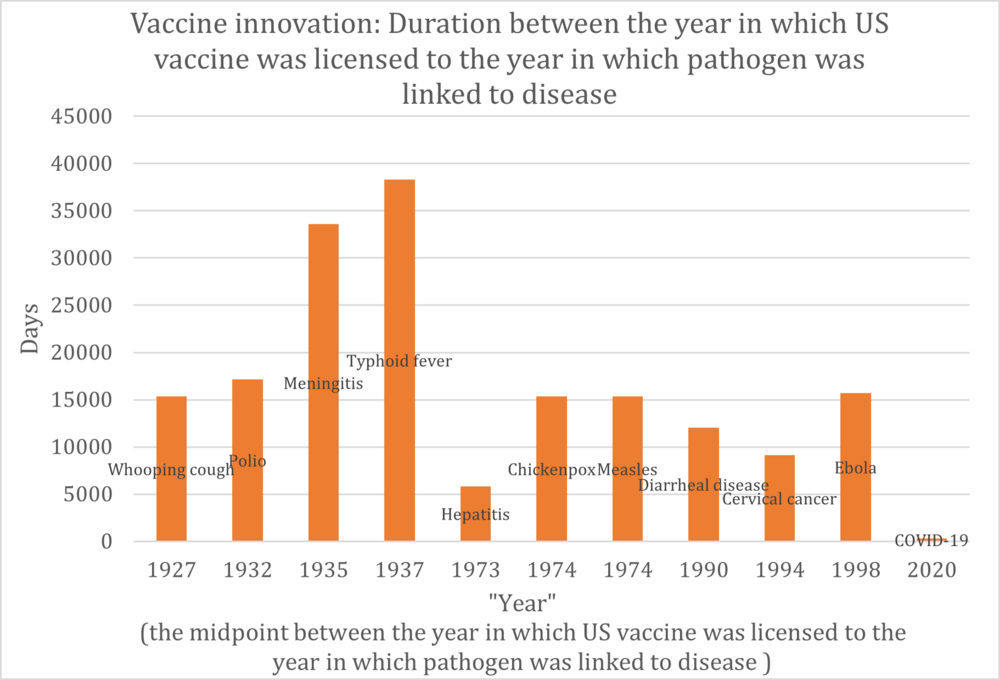
In the realm of vaccine development, different vaccines target various pathogens or conditions. It's not accurate to assume that technological advancements will necessarily shorten the development timeframe. A significant portion of the development process is the clinical trial phase, which has become lengthier in recent times. This is due to heightened awareness and stricter requirements for drug safety. Therefore, when assessing technological advancements in this field, we must also consider other Factors of Merit (FOMs) such as the drug's effectiveness and safety profile. However, even taking these into account, progress in drug development isn't always straightforward. External influences, like regulatory standards for medicines and the inherent challenges of targeting diverse diseases, can introduce significant variability in development timelines.
Next, we focused our analysis on the FOM by examining solely the vaccine development for coronaviruses. Specifically, we compared the vaccine development processes for SARS, MERS, and COVID-19(SARS-CoV-2).
COVID-19

1:Jan 11, 2019-nCov sequence released, Jan 14 VRC and Moderna Collaborate on COVID-19 vaccine design, Mar 16 1 st Phase 1 trial of USG- supported COVID-19 vaccine begins enrolling(Moderna mRNA)
2:Nov. 16 Moderna announces results of interim analysis from phase 3study
SARS
SARS
1:SARS was recognized as an emerging infectious disease in March 2003. The study from December 13, 2004 through May 2, 2005 (DNA vaccine)
Alignment with Company Strategic Drivers
XXX
Positioning of Company vs. Competition
XXX
Technical Model
XXX
Financial Model
XXX
